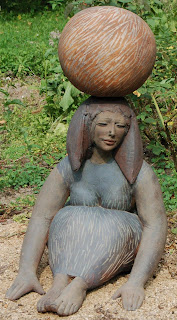 A good example is the sculpture by the famous Dutch sculptor Wessel Couzijn, which brightens up the Unilever Building on one of Rotterdam’s busy streets, the Weena. I like this piece of art, although it does not look like anything. My partner, who worked for Unilever for many years called it the “Scrap metal heap”, which certainly describes it well, and shows her appreciation for it.
A good example is the sculpture by the famous Dutch sculptor Wessel Couzijn, which brightens up the Unilever Building on one of Rotterdam’s busy streets, the Weena. I like this piece of art, although it does not look like anything. My partner, who worked for Unilever for many years called it the “Scrap metal heap”, which certainly describes it well, and shows her appreciation for it.But does the “meaning” of the sculpture becomes clearer when one knows the real title? I doubt it very much. The sculpture is entitled “Embodied unity”. I can imagine the “Aha-Erlebnis” displayed on the faces of my readers…
Despite this sort of abracadabra I really do like the sculpture.
I had a similar experience recently, when we visited the studio of Monique Dégluaire, a sculptress (who makes ceramic sculptures) living in the nearby hamlet of Bessuge. the woman makes beautiful stuff, and one day we decided to pay her a visit. Click here to join us.
 One of her works stood in the garden, not in the studio. I actually should say sat in the garden , because it was a statue of a seated woman with a ball on her head. The woman had a hairdress like Cleopatra in “Asterix and Cleopatra” (one’s got to know his classics!). People with a bit more artistic feeling should stop reading here, because the following shows my ignorance when it comes to the deeper feelings of art and artists. I am a Philistine deep in my heart, and I feel quite happy about it. Anyway, I asked the sculptor casually what the name was of this Egyptian beauty, and I got my answer. She was called “La consolation des tempêtes”, loosely translated as the “Consolation or consoler of the tempests”. February this year we had a tempest raging across France, bringing down two trees in our garden, and breaking the overhead electricity cable. I wonder who needs consolation, the storm or the victims of the storm? Or is it the idea that the tempest consoles its own victims? Ask those who lost relatives and goods in the February storm that ravaged the western parts of the Netherlands in 1953. I still clearly remember that night in 1953, when the whole family stayed up until the small hours, listening to the radio, fearing that a nearby dike would break and inundate Delft and surroundings, while the “consoling” noise of the tempest was howling around the house…
One of her works stood in the garden, not in the studio. I actually should say sat in the garden , because it was a statue of a seated woman with a ball on her head. The woman had a hairdress like Cleopatra in “Asterix and Cleopatra” (one’s got to know his classics!). People with a bit more artistic feeling should stop reading here, because the following shows my ignorance when it comes to the deeper feelings of art and artists. I am a Philistine deep in my heart, and I feel quite happy about it. Anyway, I asked the sculptor casually what the name was of this Egyptian beauty, and I got my answer. She was called “La consolation des tempêtes”, loosely translated as the “Consolation or consoler of the tempests”. February this year we had a tempest raging across France, bringing down two trees in our garden, and breaking the overhead electricity cable. I wonder who needs consolation, the storm or the victims of the storm? Or is it the idea that the tempest consoles its own victims? Ask those who lost relatives and goods in the February storm that ravaged the western parts of the Netherlands in 1953. I still clearly remember that night in 1953, when the whole family stayed up until the small hours, listening to the radio, fearing that a nearby dike would break and inundate Delft and surroundings, while the “consoling” noise of the tempest was howling around the house…Of course this has got noting to do with the beauty of the said work of art. Despite its name it is something I would not mind having in the garden.
The moral of this story: do not ask for the name of a piece of art when you like it; sometimes it is better not to know at all!
The website of La Tuilerie de Chazelle
No comments:
Post a Comment